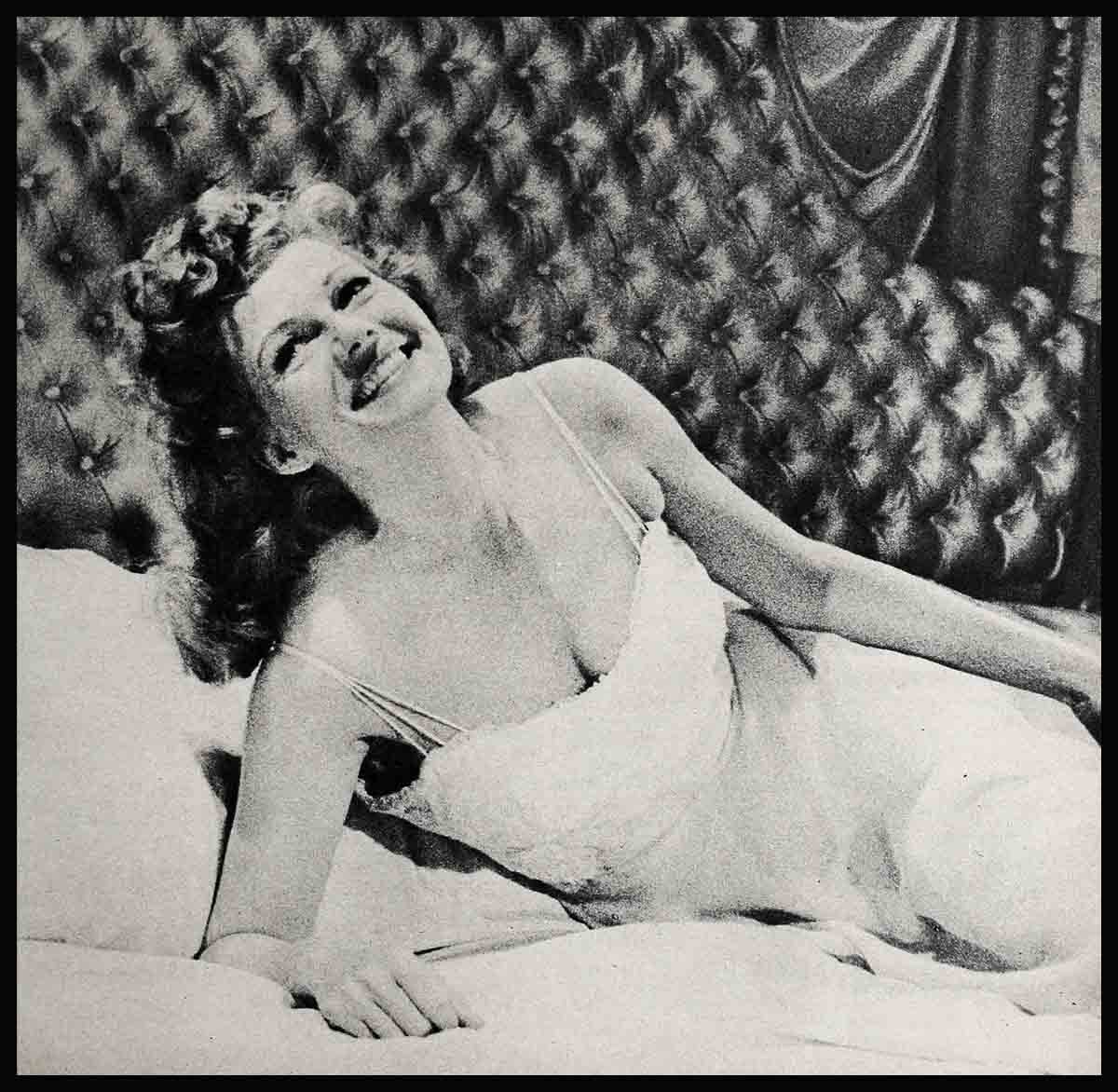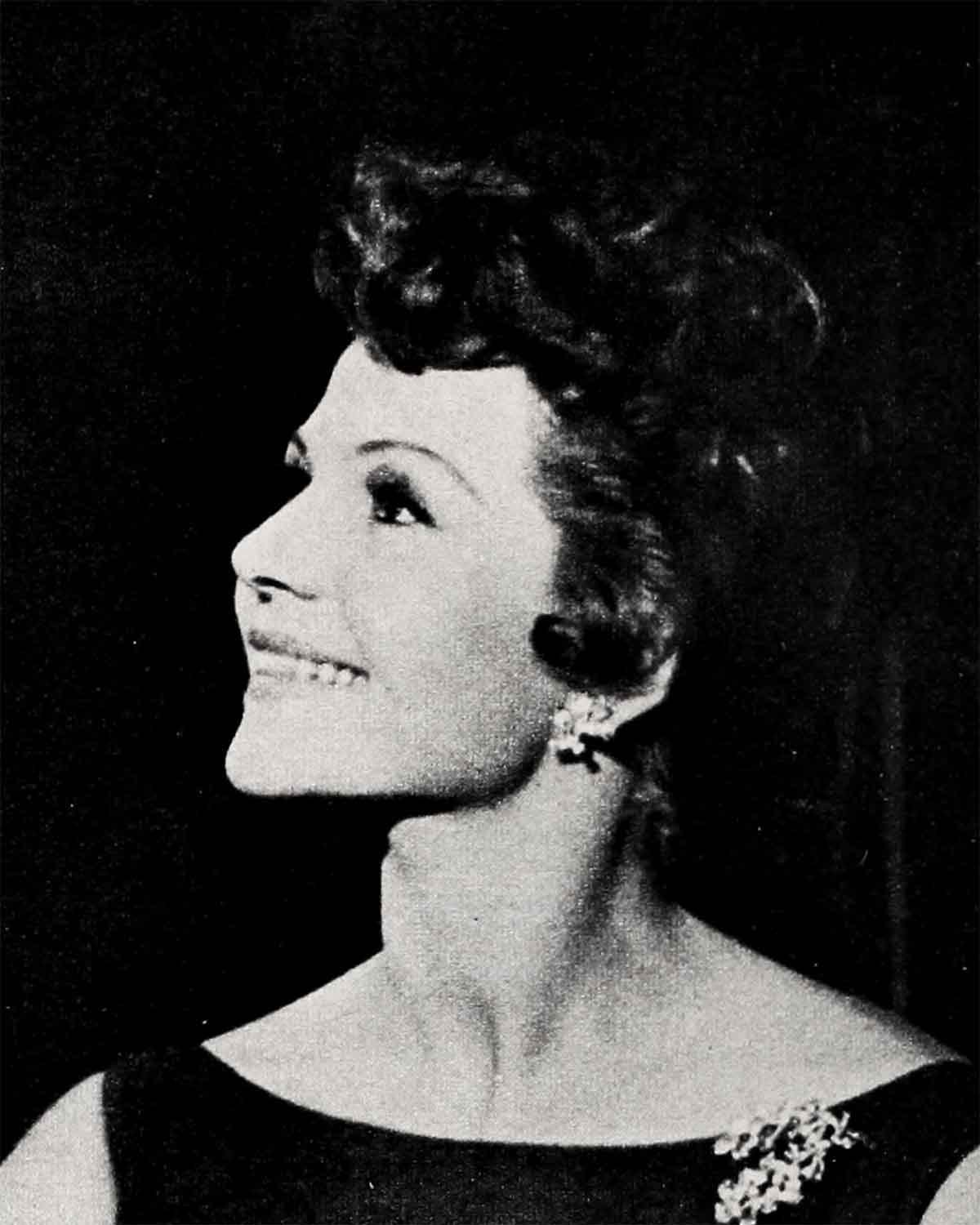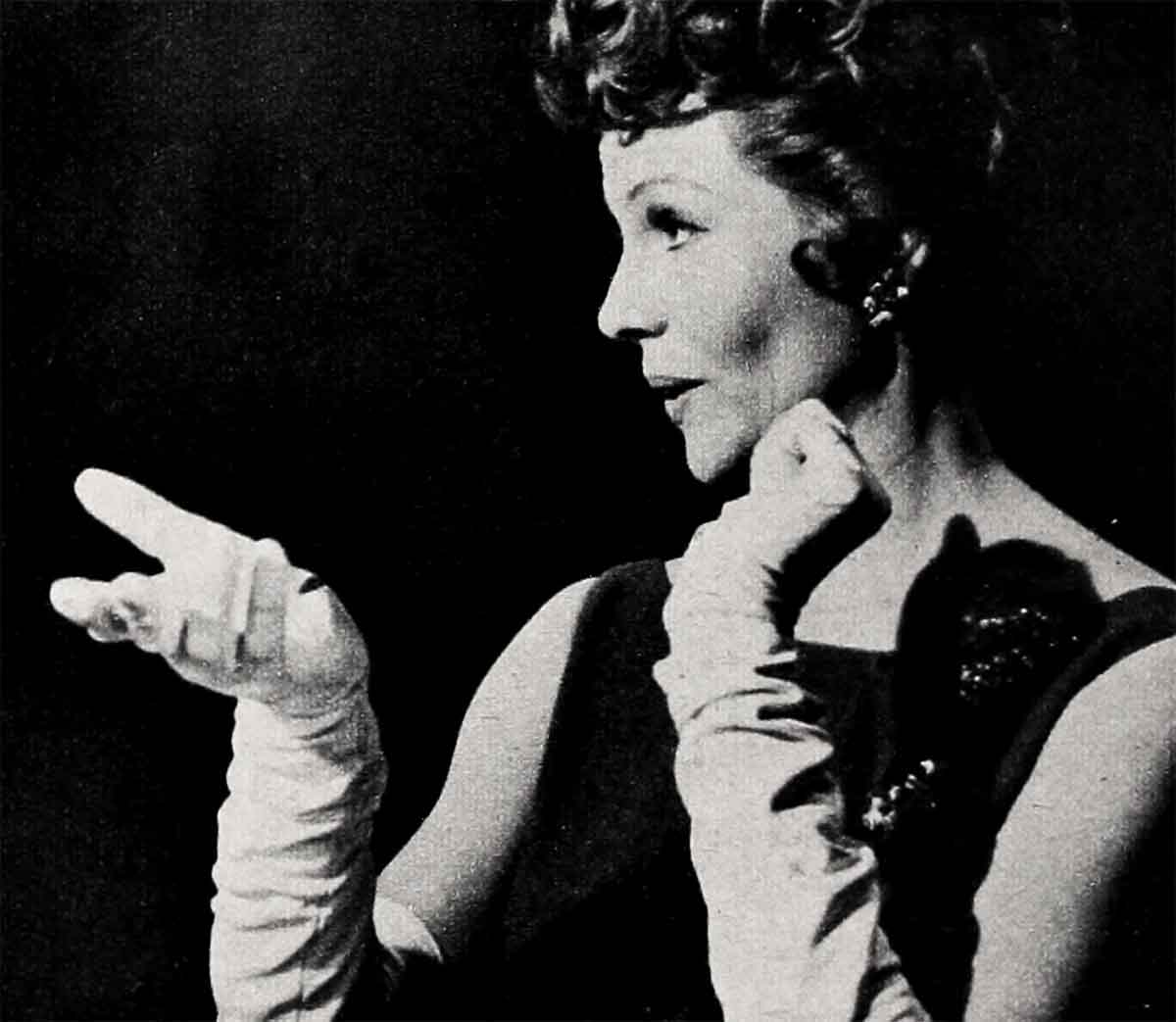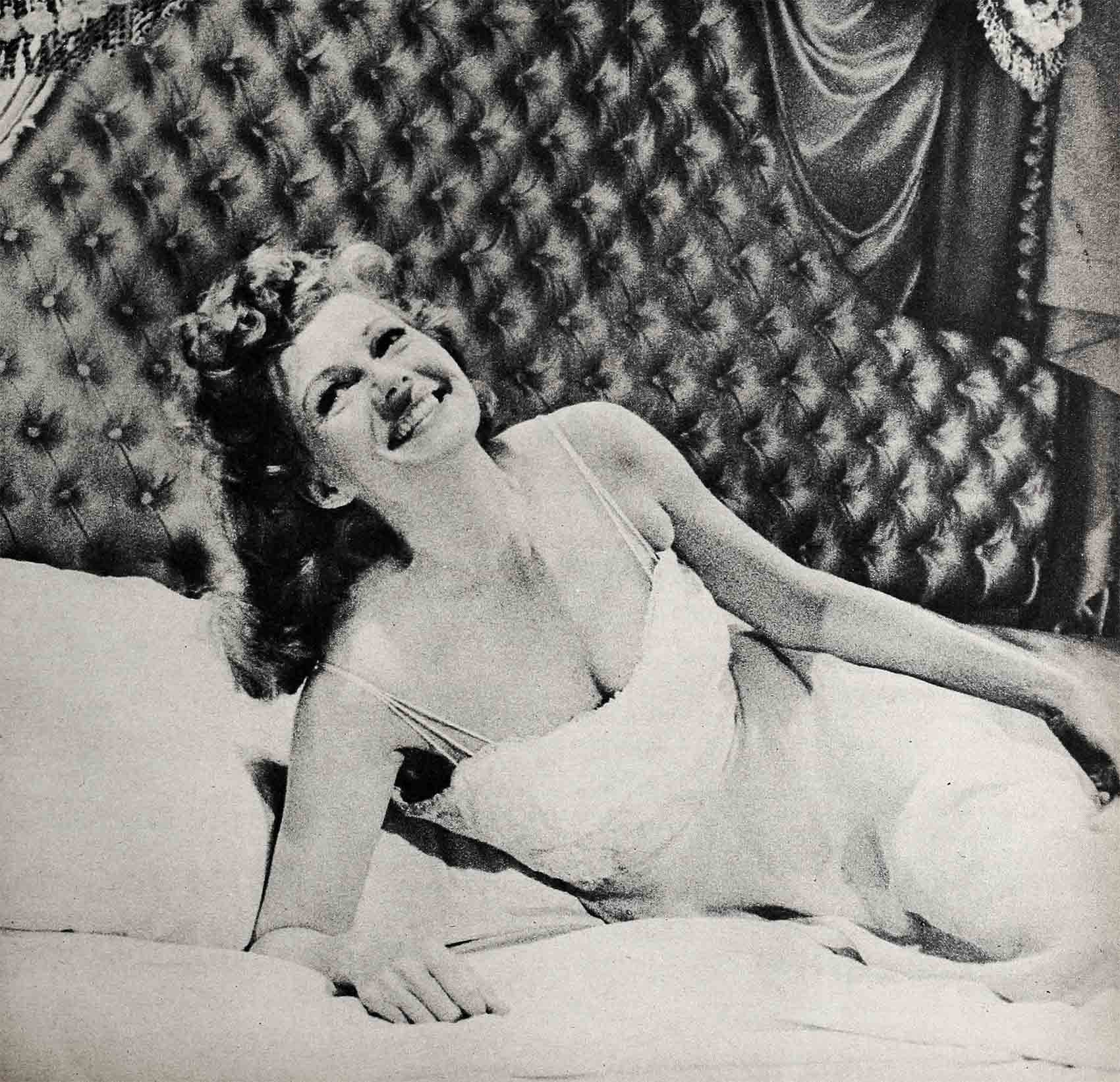
The Love Goddess—Rita Hayworth
Many men have talked about Rita Hayworth . . . Eduardo Cansino, her father: “When I looked at Margarita—a few minutes after she was born—I was terribly disappointed. I had wanted a boy. What could I do with a girl?”
Emrys Williams, her chauffeur: “Rita has a shocking temper and flings books about when she is in a rage. She was no angel. At times she had the temper of a wildcat . . . and how wonderful she looked when she was in one of her fiery rages.”
A studio executive: “Rita Hayworth is a fraud. She’s a de luxe model right out of Hollywood’s glamour factory. Her breathtaking beauty, plus publicity, fame and wealth, made her one of the most alluring packages ever to come out of the screen colony. But she’s really just a nice dull girl who has been looking all these years for a nice guy.”
Tony Martin, the man she didn’t marry: “Have you any conception of how perfect she is? There’s her sweetness as well as her beauty, her simplicity as well as her glamour. I’ve never been in love like this with anyone. I never knew I could be.”
Aly Khan, the prince she did marry: “All that she ever wanted to do was slip into something comfortable and stay around the fireside. Excitement? She was just a homebody.”
Dick Haymes, the man she shouldn’t have married: “I don’t know what I’ll do without Rita. She’s wonderful. I can’t go on without her. I’m in love with her. A man is only in love once. If she divorces me, I don’t know what I’ll do!

But few could be certain that they know her today. The Rita Hayworth who has added still another man to the list of those who have, in succession, always been at her side to mould, shape and guide her: James Hill, forty-one, brilliant, ruggedly handsome producer, partner in the independent film company of Hecht-Hill-Lancaster, and the boss of her new film, “Separate Tables.”
Their courtship was totally different from Rita’s past romances. There was none of the hoopla, none of the headlines, until news of their marriage plans leaked out. Then Hill, for whom it is a first marriage, was “surprised and distressed.” He and Rita had hoped to make all the wedding arrangements before breaking the news. They wanted a dignified wedding, “one which my parents can attend,” Hill explained.
And James Hill is quite unlike the other men in her life. If he lacks the glamour and excitement of Orson Welles, Aly Khan and Dick Haymes, he has something much more important—stability and maturity. Those who felt that Rita was always too easily swayed by surface charm were surprised at her wise choice. They should not have been. For Rita Hayworth has come a long, long way.
The disappointment of her father lies 39 years behind her now. The tears of Dick Haymes and the charm, passion, and arrogance of Aly Khan lie behind her, too. They share the same half-forgotten past with a four-year-old girl’s Spanish blouse damp and wilted from long hours of learning to dance in the bedroom of a Brooklyn apartment; with castanets flashing from the stages of endless theaters; with four marriages that cost her $100,000 and left her broke but not broken; with night on the Mediterranean and champagne for breakfast in Africa and twenty-four hours locked in a New York hotel room because two deputy sheriffs were waiting for her husband in the corridor outside.

She returned to Hollywood, to live in a quiet house on a quiet California street with her two daughters—thirteen-year-old Rebecca Welles and eight-year-old Yasmin Khan, fortieth generation descendant in a straight line from the Prophet Mohammed.
She seldom entertained. Her dates with Jim Hill were frequent but decorous, and they attracted little notice. She owned no yacht. No turtles with lighted candles on their backs swam in her pool. No champagne was drunk from satin slippers in her living room. At home, she indulged her natural tendency towards blue jeans, chewing gum and putting her feet up on the coffee table.
Today when she is shown newspapers with the name of “Marilyn Monroe” or “Jayne Mansfield” strewn across the front page, there is no jealousy in her voice as she says, “Marilyn and Jayne can have the headlines. I’ve had enough! From now on the only headlines I want are on my acting.”
In the past year she has made two movies, “Fire Down Below” with Robert Mitchum, and “Pal Joey” with Frank Sinatra. Five years of almost total absence from the screen have added an inch or two to her waistline, but they have not tarnished the copper of her hair or extinguished the steaming promise of her eyes and mouth which led 100,000 GI’s to carry her picture across the battlefields of World War II. Perhaps it was one of those GI’s who gave the most definite definition of Rita Hayworth: Sitting in the mud of a clearing hacked by machetes out of the Philippine jungle and watching “Cover Girl” on a rain-coated movie screen, he drawled, “Ah’m tellin’ you, son, that Rita Hayworth, she shore is all woman!”

Many men have felt that way about Rita Hayworth. They seem to sense that—like the essence of woman—she has always chosen to let her heart rather than her head rule her life. Her choices have often been unwise. She decided to marry Dick Haymes (“Partly because he needed her,” says a friend) after she knew much of the trouble that he was in with creditors and the United States Government. She lost $5,000 a week in salary sticking defiantly to him until his problems were settled. It was only then—after he was out of trouble—that she left him.
From almost the day of her birth, men have dominated Rita Hayworth’s life. They have taught her how to dance and what books to read and changed the color of her hair and selected her clothes. They have taught her how to walk and how to talk and how to give parties for an ex-King of England.
Says one friend who has known Rita for nearly all of the twenty years she has been in Hollywood, “Rita has always been like an empty wine glass waiting to be filled or a violin on which anyone who came by could play a melody. She had no real ambition or inner drive to be an actress. If the men in her life had not moulded and pushed her, she wouldn’t be where she is today.”
And—even today—Rita Hayworth is occasionally a little uneasy about the place where she does find herself. At least, she says a trifle wistfully, “What I’d really like to be is a painter and not have to be sold as sex or always remember to keep my stomach tucked in. But I guess that will never be . . .”
It never has been. Starting with her father, men have purposely worked to turn Margarita Carmen Cansino into the girl who became known as the Love Goddess, a symbol of sex and glamour for four of the seven continents.
For generations Eduardo Cansino’s Spanish ancestors had been dancers. Since he was burdened with a daughter, he could at least make her into a dancer to be proud of. The lessons began when Margarita was four years old. Except for a desire to be an explorer so that she could travel the world that lay outside Brooklyn, Rita remembers little else about childhood. “Rehearse, rehearse, rehearse,” she says. “That was my girl-hood.” Dancing was hard work, and she did not like it much “but I didn’t have the courage to tell my father, so I began taking the lessons.” She became a moderately good dancer—then a good one. By the time she was fourteen, she was good enough to join the family act. Instead of finishing high school, she clicked her castanets and tossed her jet black, tightly curled hair across a dozen stages.

Eduardo Cansino paid little attention until the day he looked up and “All of a sudden I wake up. Wow! She has a figure! She ain’t no baby any more.” He took her to the casino at Agua Caliente for a four-week solo engagement. The casino kept her for two years. From there, her father brought her to Hollywood for dancing specialties in two or three movies. She followed obediently. But this was as far as her father was able to propel her. And there—on the fringes of Hollywood—she might have stayed if she had not met Edward Judson.
Margarita Cansino was seventeen years old when Ed Judson telephoned her one day and told her he had seen one of the movies in which she had danced and asked for a date.
Margarita had danced for hundreds of men, but she had never gone on an un-chaperoned date in her life. “I’m sorry, but I don’t go out with men my father hasn’t met.”
Judson called again. This time he asked to speak to Eduardo Cansino. He asked politely if he might spend the evening with Cansino and his wife.
Judson was forty years old—tall, thin, and sophisticated. All of the Cansinos were overcome by his sophistication and style. At that time he was a salesman for foreign cars. The foreign cars weren’t selling well, but Judson was still a born promoter and salesman. He married Margarita and promoted her to Hollywood stardom.
Like all of the men in Rita’s life, he began by changing her and teaching her.
The first changes were external ones. The black hair was turned red and sent cascading across her shoulders. Her hairline was altered. The Spanish name was dropped and the dancing shoes neatly placed in the bedroom closet. They were not to be taken out again until sle had made a name for herself as a badish-good girl in “Only Angels Have Wings” and “Blood and Sand.”
For Rita, life with Judson was life as a puppet dangling on the end of a short string. “From the first he told me I couldn’t do anything for myself. ‘You’re such a child,’ he’d say. I didn’t have any fun those five years we were married. I was never permitted to make any decisions. He robbed everything of excitement. He was husband and nursemaid . . .”

When he took her to a tailor to have sleek-fitting skirts made, he would tell her where to stand and she would stand there motionless for hours while she was being fitted, without saying a word. Judson would do all the talking, all the choosing of color and fabric and style, and all the arguing over price.
Arguing over price was a necessity. At first Rita was not making over $75 a week. Often they had no furniture in their house. But there was always a closet full of clothes for Rita. Judson felt that the only way to make a splash in Hollywood was to dress to the teeth on the prime nights—Friday, Saturday and Sunday—and to make the rounds of the most important nightclubs. He was right. Howard Hawks saw Rita at the Trocadero one Sunday night and signed her to play with Cary Grant in “Only Angels Have Wings.”
Then—with the sudden jerk that Rita is always capable of giving in the end—the puppet broke away from the string. She was—as many were to discover—good-natured, pliable, and amenable only up to a certain point.
“I got a divorce to be myself again,” she said. “I married him for love, but he married me for an investment.” To get her freedom, she had to pay Judson a settlement. It was the first of many times she was to pay.
But she was not paying for nothing. She wasn’t quite the same little dancer who had married Ed Judson five years before. The basic niceness still remained. So did the honesty. At parties she was still too shy to ask for a cigarette, much less reach for one. But she knew how to do business with a studio now. She knew how to use a cigarette holder in public “when I want to feel important.” She knew how to spend $500 on one outfit in order to make a dramatic entrance into a nightclub where she might meet an important producer. She knew how to spend $90 of the $100 she earned each week on voice and dramatic lessons.
Her career thrived. “Susan and God.” “Strawberry Blonde. “You Were Never Lovelier.” She became engaged to Victor Mature and broke the engagement to marry Orson Welles—the eccentric and electric boy genius of the early Nineteen Forties. Orson wrote, directed, acted in, and produced movies and gave magic shows for the soldiers. At one USO show he sawed Rita in half as the climax to his act. “A hell of a way to woo a girl,” said Mature with all the grouchiness of a sure loser. But what Mature thought didn’t matter. Rita and Orson Welles were married on September 8, 1943.
Like three other Hollywood glamour queens—Lana Turner, Ava Gardner, and Marilyn Monroe—Rita Hayworth was now to be shaped and reshaped by an intellectual. and how to read. He opened her eyes to things that she had never known existed before.
Welles was always broke. He could even make money and lose money on two different plans in the same day. But it didn’t matter. For Rita, there was “You’ll Never Get Rich” with Fred Astaire, “Cover Girl” and “Gilda.” She had enough money for two. But other things mattered more. She wanted to be a real wife, and Orson didn’t need a full-time wife. He would simply forget that he had a wife and home and child. When he would remember, he would come home suddenly. Even then, he would hold conferences while he was sitting in bed—with Rita lying asleep at his side. Finally . . . “I couldn’t take his genius twenty-four hours a day any longer. I was married and yet I didn’t have a husband.”
But again she had not paid for nothing. Again some of the changes, some of the things he taught her, remained. In part at least, Welles made up for the lack of schooling. Rita is not even now an intellectual, but she can go into a bookstore and buy fifty dollars’ worth of good books and read them—really read them instead of using them to ornament her shelves.
Judson had pushed at her career. Welles had helped to open her mind. Now Aly Khan was to give her the travel that she had always yearned for.
In 1947 she had said if she had just one wish she would wish for a trip around the world, “just to roam, to live for a year like the natives in each country.” With Aly Khan she was to become a citizen of the world. Aly had villas sprinkled through Europe like chocolate shavings across the frosting of a cake.
When Rita arrived in Cannes in 1948, the director of the Casino had just finished remarking that Aly’s love affairs were losing the resort some of its best clients because patrons were fearful of letting their wives and daughters within reach of his charms. Aly sat next to Rita at an Elsa Maxwell dinner party and—within days—the Casino director didn’t have to worry.
They were married on May 27, 1949. Aly’s Riviera swimming pool was aglow with candles and drenched in flowers for the occasion and Rita ordered essence of orange blossoms to scent the pool. There was lobster and caviar and fifteen bottles of champagne per guest. She wore a $1,000 ice-blue gown, and Aly leaned forward and kissed her foot.
“Are you happy?” someone asked.
“I never knew what happiness was before,” she answered.
The next day there was a Moslem ceremony. “Fear Allah as he should be feared. Who so obeys Allah and his Messenger shall surely attain mighty success.”
The mighty success—at least of their marriage—did not last long. Aly traveled from gambling casino to gambling casino, from race track to race track, from villa to Swiss chalet to villa. When he broke his leg in Switzerland, he arranged for his son, Karim (the new Aga Khan) and his chauffeur, Emrys Williams, to sneak him out of the chalet and fly him to England, where one of his horses was running. His father was the richest man in the world, but Aly could never keep a franc in his pockets for very long.
According to Emrys Williams, “One of the first causes of Miss Hayworth’s unhappiness, in her role as Princess Aly, stemmed from the fact that she nearly always felt like a fish out of water with the Prince’s friends. My boss lived for horses, and enjoyed nothing more than the company of trainers, owners, and jockeys.” Most of these friends couldn’t speak English, and Rita found it hard to learn French.
She tried to make a home out of one of the smallest of the villas. But Aly was still Moslem enough not to want a wife who was an equal partner. The duty of a Moslem wife was to be available when her husband wanted her available and to disappear discreetly when he was busy with his friends. There were quarrels and then a safari to Africa that was to be a second honeymoon. But—like almost everything that Aly did—the safari was gigantic. The second honeymoon included four Moslem millionaires who came along to play bridge with Aly, two cooks, one valet, two pilots, three secretaries, two aides, and some French socialites who joined them en route. There was one truck for the champagne and another for the refrigerators.
Rita flew back home to France. From there she went to America with the children. “I don’t want to live in a house where there are eighty friends of all kinds coming and going, and I don’t want to be photographed in the salons of Paris or at dinner in big restaurants.” Later, she added, “He is a playboy. He doesn’t understand family life. He thinks only of gambling, horse racing, big game hunting.”
As usual Rita was left in debt. She had to borrow $25,000. Also as usual, she felt little bitterness. The experience of being a princess had brought her sophistication; made her cosmopolitan; and given her—at last—the travel she had hungered for from the day early in childhood when she had wished she were a boy so that she could become a sailor and sail around the world.
If there was one marriage that was predestined to failure before the ink on the marriage license was dry, it was Rita’s marriage to singer Dick Haymes. In 1948 Haymes had been the hottest young singer in Hollywood, but—in that inexplicable fashion that things happen in Hollywood—his career had soured overnight. By the time of their marriage in September of 1953, Haymes was desperately broke and almost bankrupt. One month later he was arrested for being behind in his alimony payments to ex-wife Joanne Dru. A few days later a Deputy Marshal handed him a $1,071.37 bill from a men’s clothing store. The Internal Revenue Bureau attached his earnings. A gasoline attendant sued him for an $80 gas bill. Then the United States Government attempted to deport him because of a waiver he had signed to be free from military service during World War II. It took two years before the government dropped its case. Rita stuck to him until all his troubles were settled.
“Basically,” says one friend, “Rita has eluded the attempts of all her husbands and studio advisors to change her. She has an uncanny ability to stay herself, to be really untouched by all the overpowering things that have happened—even though on the surface she has acquired gloss and polish and sophistication. For example; when Judson was choosing her clothes, she was selected as the best-dressed starlet in Hollywood. A few years ago, when she was choosing her own, she was picked as the worst-dressed.”
And now, Jim Hill has filled the need in Rita’s life for a man to lean upon, and listen to. But will he find, as so many others before him, that in spite of her pliance, her longing to be led, there is about her something still that will always be hers, and hers alone? It is this aura of individuality that took her out of the ranks of ordinary starlets and made her The Love Goddess. Some call it glamour. Some call it personality. Neither word quite describes it. But it is there. It cannot be touched. It cannot be changed.
Perhaps it is true that Rita has no inner drive, that she has—in effect—been manufactured by the men who have come in contact with her. Perhaps it is true that if it hadn’t been for these men’ she would today be a housewife in some small midwestern town. And yet pérhaps it is not true. Perhaps they are, all of them, only the humble attendants to the girl who inevitably became The Love Goddess.
THE END
—BY JANET REA MILLS
It is a quote. PHOTOPLAY MAGAZINE FEBRUARY 1958




